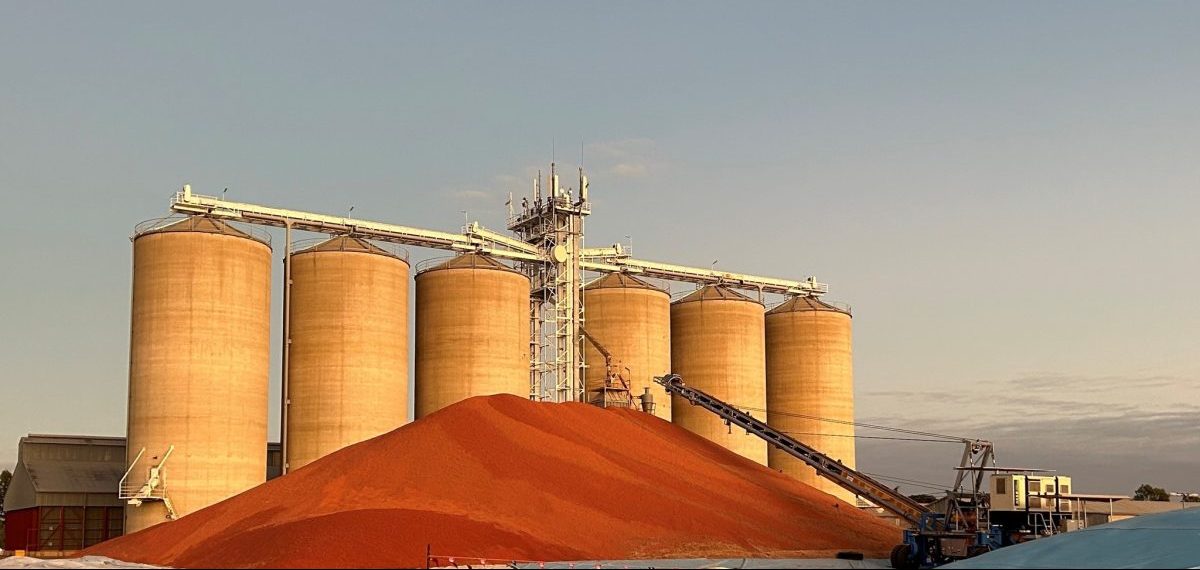
A sorghum bunker builds at GrainCorp’s Moura site in Central Qld earlier this month. Photo: Brad Foster
PRICES for feed wheat and barley have firmed in the past week as dry conditions in much of north-west New South Wales prevail and the planting window for short-season wheat gets close to its nominal end date.
In contrast, showers and storms over Victoria, South Australia and southern NSW are keeping production prospects for establishing crops on track for at least average yields, provided spring is kind.
Traders report grower interest in selling is as subdued as export and domestic interest in buying.
The exception is sorghum, which is being harvested, delivered and sold at pace in Central Queensland.
| Today | Jun 8 | New crop | ||
| Barley Downs | $435 | $428 | NQ | |
| SFW wheat Downs | $425 | $415 | NQ | |
| Sorghum Downs | $390 | $373 | NQ | |
| Barley Melbourne | $355 | $352 | $352 | |
| ASW Melbourne | $395 | $400 | $397 | |
| SFW Melbourne | $390 | $395 | NQ |
Table 1: Indicative prices in Australian dollars per tonne.
Sorghum prices leap in north
Barley prices delivered to southern Queensland’s Downs region have firmed further this week, despite a considerable volume from as far south as the NSW Riverina now making its way by road into Downs feedlots.
“There’s not a lot of white grain on our doorstep, and people are chasing barley in particular for the feedlots,” one trader said.
Sorghum harvesting is at full pace in Central Qld, where yields are good and GrainCorp depots are said to be filling fast as the bulk shipping program ex Gladstone and Mackay kicks off.
In southern Qld, container business for China is behind most of the trade now that harvest in the region is over.
“I don’t think there’s much sorghum left in southern Qld.”
“People took advantage of good depot prices and whacked it through at harvest.”
In northern NSW, rainfall totals in the week to 9am today include: Moree 12mm; Mungindi 11mm; Narrabri 23mm, and Walgett 14mm.
AgVantage Commodities trader Brendon Warnock, Narrabri, said crop conditions north to about Bellata are reasonable, and the recent 15-20mm has been ideal.
However, conditions deteriorate north to the Qld border and west to Walgett.
“A lot of growers we work with north and west of Narrabri…are struggling to get a crop in,” Mr Warnock said.
“Some haven’t planted at all.”
The flipside is that early-sown wheat, canola and faba beans are faring well, and on the marketing front, Mr Warnock said the outlook for a dry spring has growers reluctant to forward sell new crop.
“We haven’t had a lot of demand for people wanting to price forward.”
More competitive freight rates for containers coupled with reasonable domestic demand for APW and higher grades has seen non-feed wheat trade at $450/t delivered Brisbane.
Barley is expected to be the crop that is planted over a reasonable chunk of the north-west NSW plains if 20mm plus of rain falls in the next fortnight.
As expected, weaker livestock prices have brought opportunity sheep and cattle feedlotters back into the market across eastern Australia.
That means mixed farmers are either value-adding their own barley, SFW wheat, faba beans or lupins, or buying parcels in the cash market.
Cottonseed firms
Cottonseed values have firmed in the past week as the percentage of cotton ginned for this time of year lags due to late start.
“Cottonseed prices are competitive verses grains domestically, but they’re not export competitive,” Woodside Commodities managing director Hamish Steele-Park said.
“USA seed values remain lower on a destination basis.”
Cottonseed this week has been trading at $405-$410 ex Moree gin, while the delivered Downs market is sitting at around $465-$470/t from July-September, and the ex southern NSW gin market is $440-$445/t.
In the container market, cottonseed is trading at $550-$560/t DCT, depending on months of delivery.
Rain shores up southern outlook
Most of Victoria’s graingrowing country has had 5-15mm of rain in the past week to kick crops along, and South Australia has also had some handy falls of 5-20mm.
Higher registrations in SA include: Bordertown 40mm; Cummins 28mm, and Pinnaroo 29mm.
Pockets of southern and central NSW have also had 5-10mm to improve prospects for cereals sown last month.
Key Agri broker Matt Noonan said while the El Niño alert is in back of people’s minds, recent rain from the Riverina and down to the Vic border has been ideal.
“That’s joined up the topsoil moisture with the subsoil, and those crops can really get their roots down now.”
Mr Noonan said consumers were buying hand to mouth, and that may change once the new financial year starts on July 1 and growers take the brakes off on their selling programs.
He said the bigger question for consumers might be: How much grain has been exported?
“In hindsight, it could be too much.”
On wheat, USDA forecasts Australia’s current-crop exports at 31 million tonnes (Mt), up from 27Mt seen at the start of the Australian harvest.
The strength of Australian pricing over export parity indicates stocks are indeed tighter than expected after a massive wheat export program which is continuing into this month.
Mr Noonan said cheaper sheep and cattle prices were generating some additional domestic demand, and holding back grower-owned stocks from the market.
“Store lambs, and weaners and dry cows are cheap enough…that you can do a job on them.”
“From February, you saw some livestock feeding demand turn up, and you’ll see a little bit more if sheep and cattle prices stay where they are.
“Cattle prices are allowing feedlots to load right up,”
Grain Central: Get our free news straight to your inbox – Click here

HAVE YOUR SAY